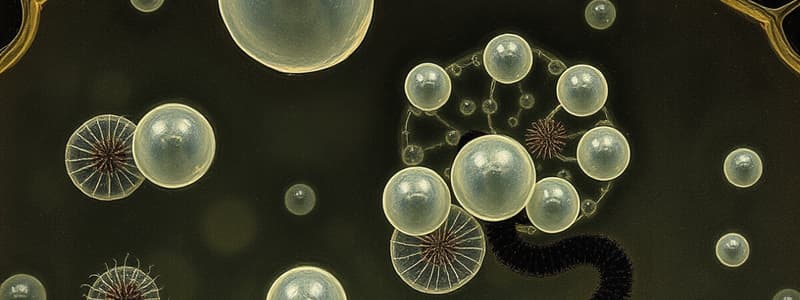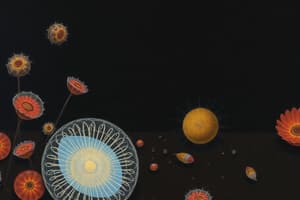Podcast
Questions and Answers
What is the primary function of the Golgi apparatus in a cell?
What is the primary function of the Golgi apparatus in a cell?
- Synthesizing ATP for energy
- Decomposing waste materials
- Transporting proteins from the nucleus
- Processing and distributing cellular products (correct)
Which organelle is responsible for maintaining cell shape and organization during cell division?
Which organelle is responsible for maintaining cell shape and organization during cell division?
- Golgi apparatus
- Cytoskeleton (correct)
- Lysosomes
- Endoplasmic reticulum
What distinguishes the rough endoplasmic reticulum from the smooth endoplasmic reticulum?
What distinguishes the rough endoplasmic reticulum from the smooth endoplasmic reticulum?
- Function in lipid synthesis
- Storage of calcium ions
- Presence of ribosomes on its surface (correct)
- Role in detoxifying chemicals
What is a major function of mitochondria in the cell?
What is a major function of mitochondria in the cell?
Which of the following features is unique to plant cells and not found in animal cells?
Which of the following features is unique to plant cells and not found in animal cells?
What role do lysosomes play in animal cells?
What role do lysosomes play in animal cells?
What structure provides support and alters the shape of cells?
What structure provides support and alters the shape of cells?
Which organelle serves in storage and pressure control within plant cells?
Which organelle serves in storage and pressure control within plant cells?
What function does the nucleus primarily serve within a cell?
What function does the nucleus primarily serve within a cell?
Which organelle is responsible for cellular respiration and energy production?
Which organelle is responsible for cellular respiration and energy production?
What are the two types of endoplasmic reticulum found within cells?
What are the two types of endoplasmic reticulum found within cells?
What is the primary function of the Golgi apparatus?
What is the primary function of the Golgi apparatus?
How does the role of the nucleolus differ from that of the nucleus?
How does the role of the nucleolus differ from that of the nucleus?
What distinguishes rough ER from smooth ER?
What distinguishes rough ER from smooth ER?
Which statement about mitochondria and plastids is correct?
Which statement about mitochondria and plastids is correct?
What is the structural significance of the Golgi apparatus in relation to the nucleus?
What is the structural significance of the Golgi apparatus in relation to the nucleus?
Flashcards are hidden until you start studying
Study Notes
Overview of Cells
- Cells are the fundamental units of life, either unicellular (single-celled organisms) or multicellular (composed of multiple cells).
- Cells can be envisioned as building blocks, forming tissues, organs, and entire organisms like Lego blocks.
Cell Membrane and Cytoplasm
- The cell membrane is a double layer of phospholipids that protects the cell and separates it from the extracellular environment.
- Cytoplasm, also called cytosol, is a gelatinous substance within the cell that houses organelles.
Nucleus
- The nucleus is a prominent organelle containing the nuclear membrane, regulating cellular functions, and storing genetic information.
- The nucleolus, within the nucleus, is responsible for ribosome production, essential for protein assembly.
Metabolic Organelles
- Mitochondria are the powerhouses, facilitating cellular respiration and breaking down glucose for energy.
- Plastids, found in photosynthetic organisms, capture sunlight energy to synthesize glucose.
Endoplasmic Reticulum (ER)
- The rough ER, studded with ribosomes, synthesizes proteins; whereas the smooth ER lacks ribosomes and synthesizes other cellular products.
Golgi Apparatus
- The Golgi apparatus receives, processes, and distributes cellular products from the ER via vesicles, temporary storage and transport units.
Lysosomes
- Lysosomes are membrane-bound vesicles in animal cells containing enzymes for breaking down waste and invasive organisms, aiding in cellular cleanup.
Cytoskeleton and Locomotory Organelles
- The cytoskeleton provides structural support, allowing for cell shape alterations and the formation of organelles like cilia, pseudopodia, and flagella.
Centrioles
- Centrioles, located near the nucleus, maintain cell shape and organization during cell division and are collectively known as the centrosome.
Central Vacuole
- Plant cells feature a large central vacuole for storage and pressure regulation, substituting for lysosomes found in animal cells.
Cell Wall
- Certain cells possess a rigid outer cell wall made of various substances: cellulose in plants and algae, chitin in fungi, peptidoglycan in bacteria, and pseudopeptidoglycan in archaea.
Unique Features of Plant vs. Animal Cells
- Plant cells: contain cell walls, plastids (e.g., chloroplasts), and central vacuoles.
- Animal cells: have lysosomes and centrioles, but lack cell walls, central vacuoles, and plastids.
Implications for Classification
- The presence and type of cellular features significantly inform the classification schemes utilized by biologists.
Studying That Suits You
Use AI to generate personalized quizzes and flashcards to suit your learning preferences.




